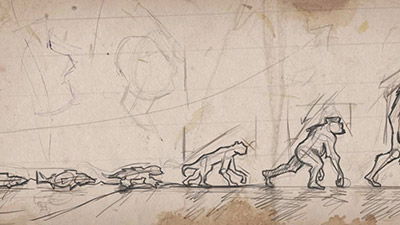
Human Ingenuity: Outsmarting Evolutionary Misconceptions
In our day of Walmart, Amazon Prime, and hardware stores, with every material conceivable, it is hard to imagine a time when, if you needed something, you had to make it from the limited materials available to you. And because we now enjoy the fruit of several thousand years of research, innovation, and creativity, it is easy to get in the mindset that we are more intelligent than those who have gone before us.
When we start with God’s Word, however, we know that humans are not necessarily getting smarter as time goes on. Adam and Eve were created in God’s image (Genesis 1:27), and originally we had perfect brains and intelligence (Genesis 1:31; Deuteronomy 32:4). But our brains are now subjected to a sin-cursed world. So the overall state of mankind is actually worse—not better—as mutations and other genetic problems stack up with time.
Man was intelligent from the very beginning. Here are just two examples that were in the news recently.
Wanted: Iron from Outer Space
If you’re looking for accessible iron, look in our planet’s outer crust. From there it can be mined, smelted, and made into all kinds of useful objects. But that’s not the only place you can find iron. This metal also arrives in some meteorites from outer space.
Iron that falls from the sky can have recognizably different compositions from terrestrial iron, often featuring much more nickel and cobalt—although we can mimic this mixture easily enough. And, according to a new study, ancient people knew to use this iron to make daggers, axes, and even jewelry.1 Researchers tested the iron found in weapons, tools, and jewelry from Egypt, the Near East, and China with X-ray florescence spectrometry. This method allowed them to determine the composition of the iron and other materials, alerting them to the fact that its origin may be out of this world.
The iron used to make the pharaoh’s dagger, bracelet, and headrest came from at least two different meteorites.
It appears ancient people searched for and made a business from selling this valuable iron. Ancient, post-Babel texts described the price of iron as 10 times that of gold, with the price plummeting once iron smelting was rediscovered at the start of the so-called “Iron Age.” In Tutankhamun’s tomb, researchers found another clue that there was indeed an ancient iron trade. The iron used to make the pharaoh’s dagger, bracelet, and headrest potentially came from at least two different meteorites.
Iron was actively mined and smelted only a few generations after Adam (Genesis 4:22). Noah and his sons likely carried this knowledge with them through the Flood, but at the dispersion at Babel, some people groups lost the ability to smelt iron or it took several generations to reestablish this trade. Also, it’s easier to use a large piece of iron, readily accessible in a meteorite, than it is to get similar material from mining. As civilization reestablished itself post-Babel, our ancestors used what they could find to make what they needed—including material from meteorites.
How to Make Your Home in the Desert
The desert is a highly inhospitable place to eke out a living. Yet it seems no matter where or when in history humans choose to settle, they come up with ingenious ways of surviving and thriving in that environment.
After the dispersion at the Tower of Babel, people groups started migrating around the world. As the climate drastically changed during the Ice Age and then settled down, our ancestors met new challenges in the frigid Arctic, arid deserts, open grasslands, and more. Yet they settled these areas, thriving for generations—in fact, some continue to thrive today.
After the dispersion at the Tower of Babel, people groups started migrating around the world.
One group eventually made its way into the east-central region of what is today known as Arizona. In this arid area they found shelter in what already existed there—the geological formations. Hundreds, perhaps even thousands, of small villages are dotted throughout this area, carved right into the sandstone rock formations.
One such city, occupied from about AD 1150 to 1350 and featured recently on Live Science is known as Honanki.2 Erosion wore an alcove into one sandstone formation, and the people who settled this area capitalized on it. The pueblo (communal settlements) they created once stood two stories high and featured 72 rooms. Some rooms were used for food storage, others for family dwelling, and one is believed to have been a birthing room. Some 2,000 pictographs and petroglyphs still decorate the stone walls, giving us hints about this people’s culture and practices.
Mankind: Intelligent from the Beginning
Evolutionary thinking teaches that man was primitive and has evolved to greater intelligence. Due to this teaching, many people have mistakenly extrapolated this to mean that we’re smarter today than many of those who have gone before us, even in relatively recent times (e.g. poking fun at people from the so-called Dark Ages as if they were all merely superstitious bumpkins). But all humans throughout earth’s 6,000-year history have been made in the image of God (Genesis 1:27). Humans have been intelligent, creative, full of ingenuity, and capable of impressive feats since the Garden of Eden. And we have always used this intelligence, combined with accumulated technology and resources available, to solve problems and thrive in this sin-cursed world and its environments.
Footnotes
- Tom Metcalfe, “King Tut’s Dagger Is ‘Out of This World’,” Live Science, December 18, 2017, https://www.livescience.com/61214-king-tut-dagger-outer-space.html.
- Linda Buscher and Dick Buscher, “Honanki Ruins: Photos Reveal Sprawling, Ancient Pueblos,” Live Science, December 17, 2017, https://www.livescience.com/60659-honanki-photos.html.

Answers in Genesis is an apologetics ministry, dedicated to helping Christians defend their faith and proclaim the good news of Jesus Christ.
- Customer Service 800.778.3390
- Available Monday–Friday | 9 AM–5 PM ET
- © 2025 Answers in Genesis



